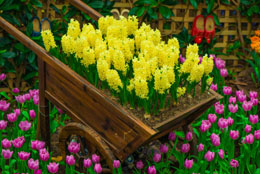Blooming flowers are a delightful sight that is not only appealing visually, but also touches the soul. There are many kinds of flowers that grow in our gardens, and this article will help you with perennial flower identification.

"Flowers are the sweetest things God ever made, and forgot to put a soul into." ― Henry Beecher
Blossoming flowers enthrall one and all, and bring joy and pleasure to all sunken souls. They are given as a token of love and appreciation, or also given to sick people as a "get well soon" wish. Flowers spread love and joy to the world with their mesmerizing colors, shapes, and fragrances.
As a garden owner, you take a lot of pains to grow these timeless beauties that make your garden the most beautiful in the neighborhood. You have always proudly displayed your flowering beauties to everyone who visits you. You may have many times faced a common question, "What is the name of this beautiful flower?". This becomes a very embarrassing question at times when you yourself cannot identify it. This article will help you with the identification of perennial flowers.
Identifying Perennial Flowers
Identification of flowers is based on the overall identification of the plant. Perennial flower plants are ornamental plants that live for 2-3 years. These short-lived plants do not die after one season of growth, they survive the winters and grow every spring. There are many plant seeds available in the nursery that can be used to grow perennial flower plants. These plants burst into color every year during the same time. There are many types of perennial garden flowers available for every season and climate. The perennial flowers make your garden full of colors all year round. These plants range from low-growing shrubs to tall plants. There are plants that have bright colors, colorful leaves, and glowing seed heads similar to a few ornamental grasses. These plants are excellent for covering a shady spot. Another method of identification is that they are easy to grow and maintain.
Types of Perennial Flowers
- Full Sun Perennials:
These flowers grow well in areas that receive 6 to 8 hours of direct sunlight everyday. These include Lavender, Astilbe, Salvia, Artemisia, Chrysanthemum, Iris, Poppy, Japanese Anemone, and Day Lily.
- Part Shade Perennials:
These plants do not require full sunlight and grow well in partial shade. They are found growing under trees that have sunlight penetrating through their foliage. These flowers include Primrose, Bleeding Heart, Foxglove, and Ligularia.
- Full Shade Perennials:
Seeds of these plants should be planted in an area that is in devoid of sunlight. These shade-loving flowers survive under evergreen trees and thickly branched trees. These includes Ferns, Amsonia, Pulmonaria, Brunnera, and Hosta.
- Dry Soil Perennials:
These plants require dry climate and very little water for growth. They can grow well in dry soil gardens, and you do not require to water them frequently. These include Lavender, Amsonia, Bluestar, Wormwood, and Yarrow.
- Average Soil Perennials:
The soil containing equal amount of sand, silt, and clay is perfect to grow perennial flower seeds. These plants require enough sunlight and water to grow. These include Meadow Sage, Alstroemeria, Aster, Columbine, Geranium, and Peony.
- Moist Soil Perennials:
These plants thrive in soil that is constantly wet. They grow in moist soil and blossom even after a heavy downpour. These include Cardinal Flower, Brunnera, Astilbe, Pulmonaria, Iris, and Foxglove.
Some other identification tips include that the plant should be able to grow outdoors and should be of temperate climate. The seeds of these plants are also shed like the annual plants, but they take at least one more year to grow. The other way to identify is to take a sample to the local nursery and ask them for help. You can also use the modern tool, the Internet, and search for similar looking plants, or upload a picture of the flower online and ask people to answer your query. You can even ask Cooperative Extension Agent in your area for help in identifying your perennial garden flower.






 "Flowers are the sweetest things God ever made, and forgot to put a soul into." ― Henry Beecher
"Flowers are the sweetest things God ever made, and forgot to put a soul into." ― Henry Beecher